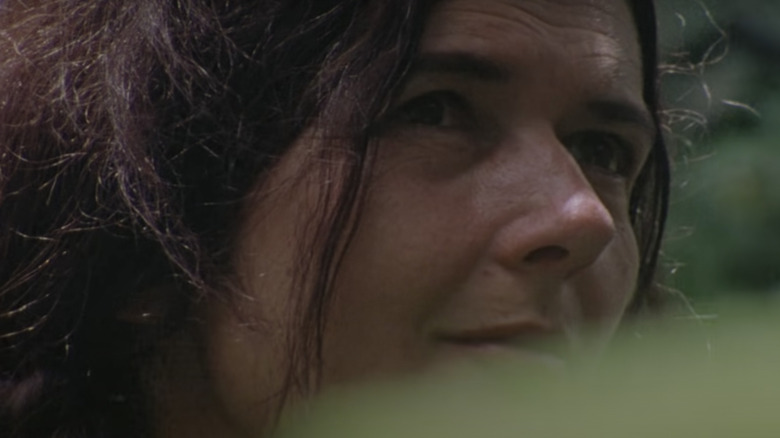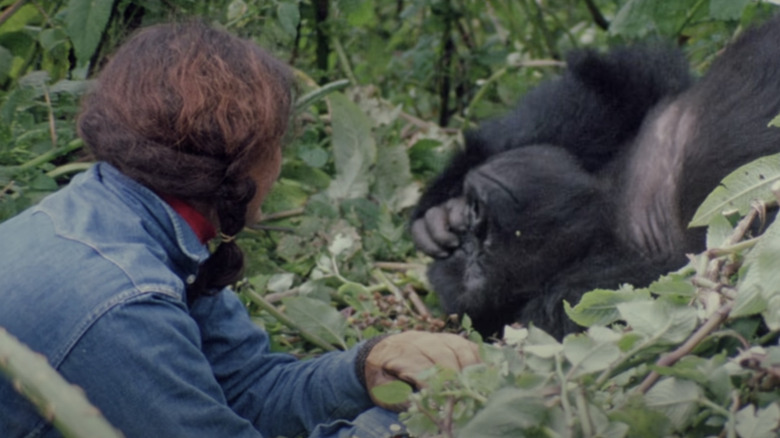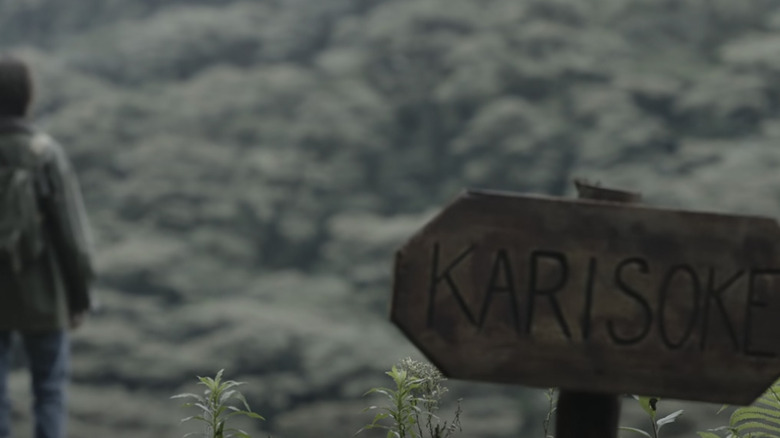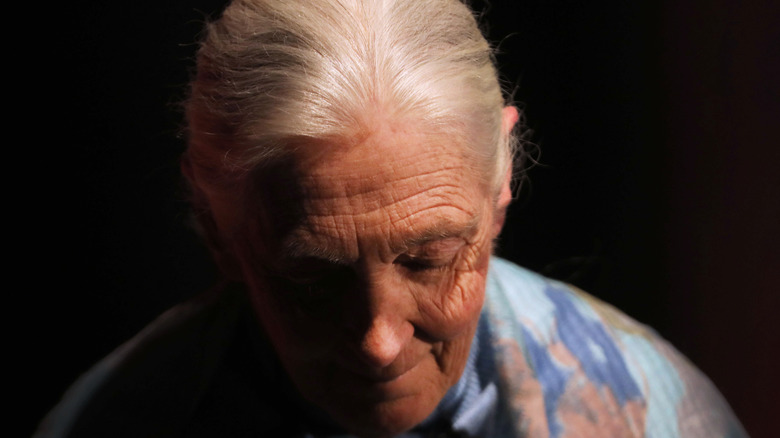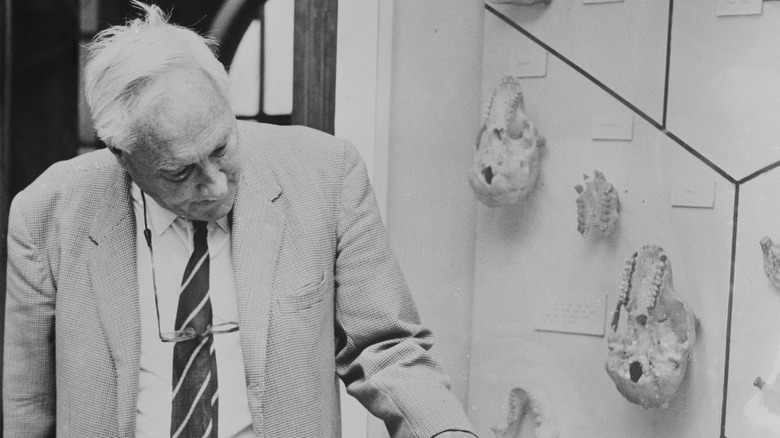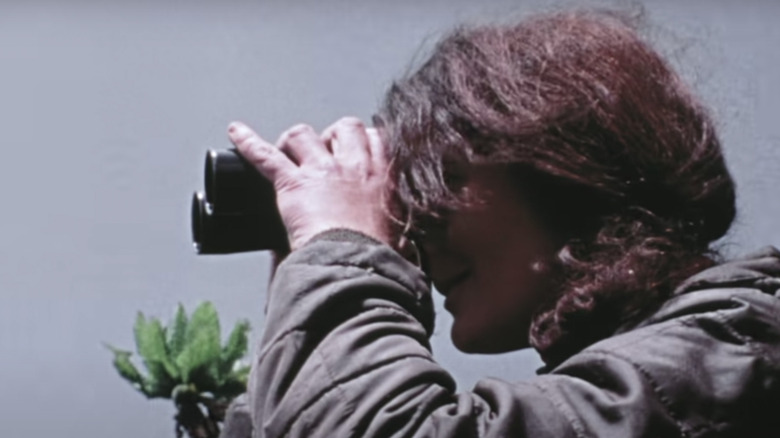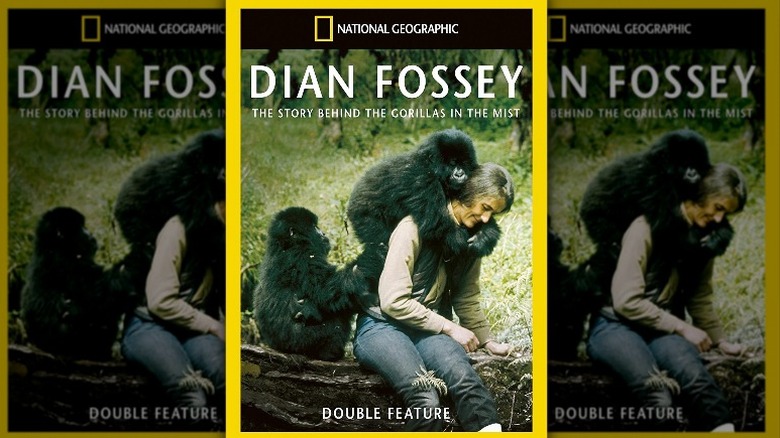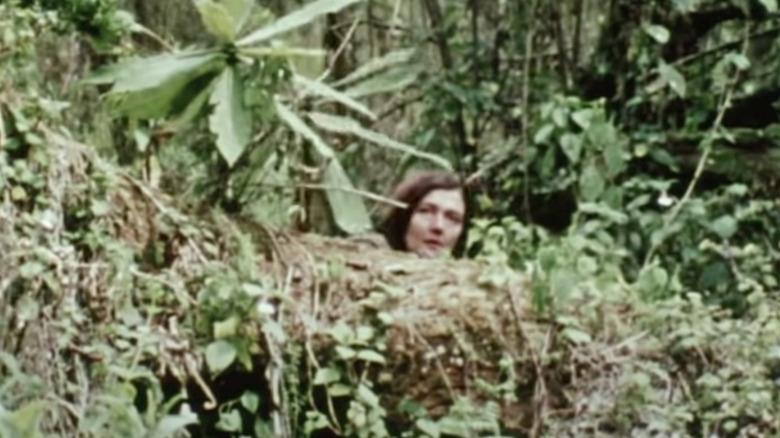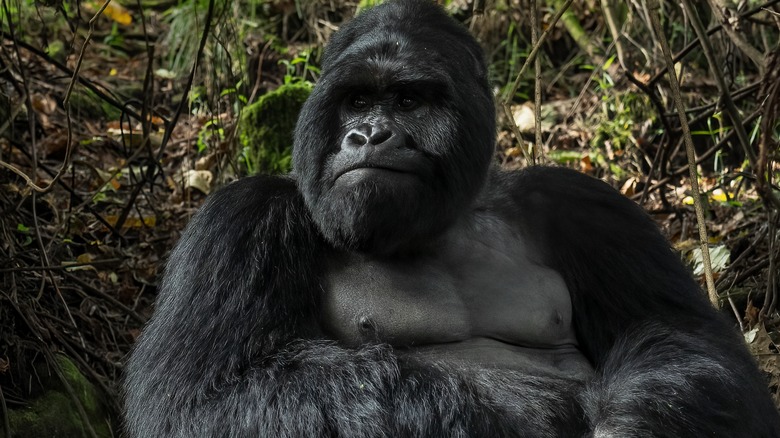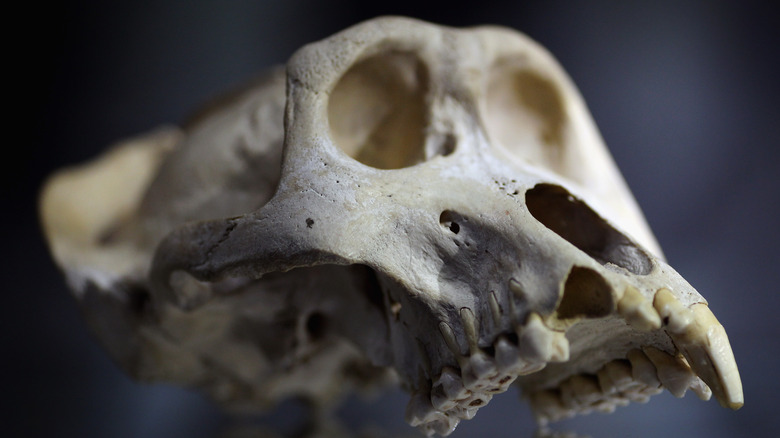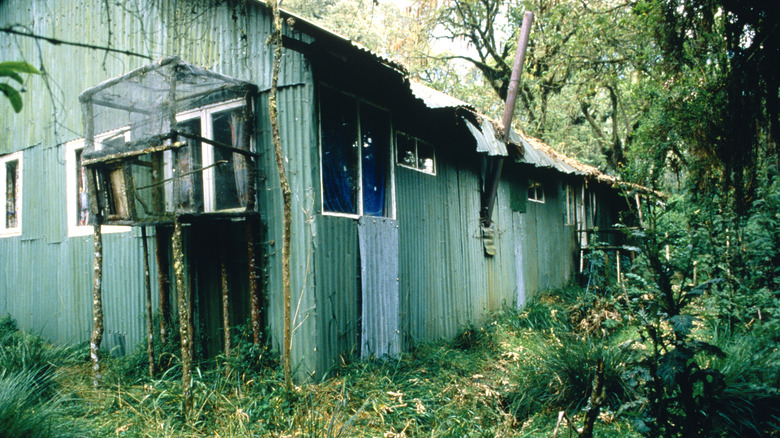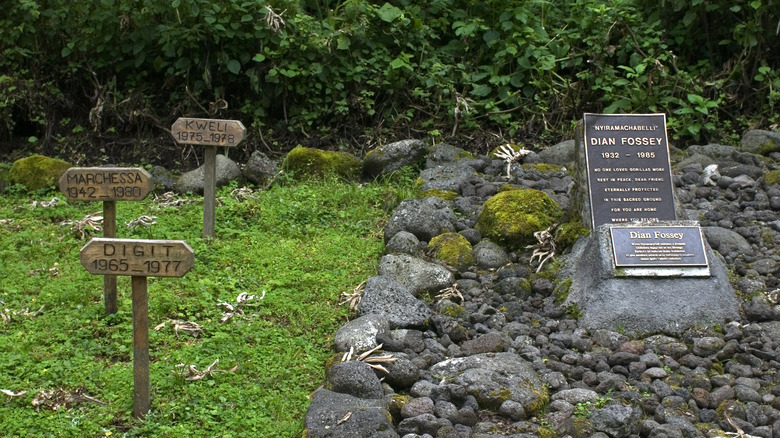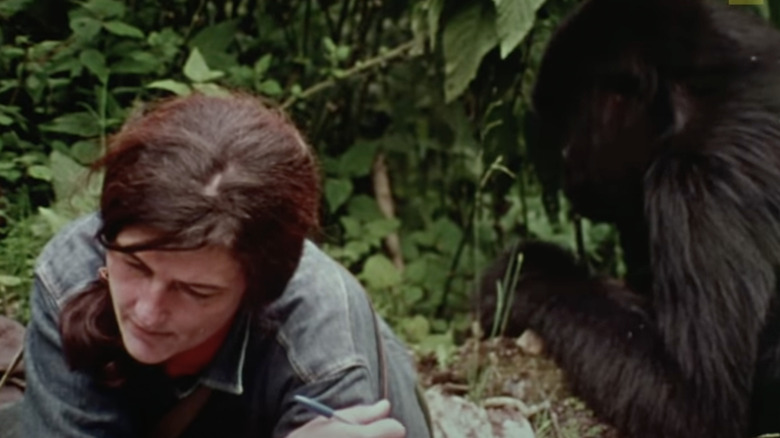The Legacy Of Dian Fossey: Facts About The Legendary Primatologist
Dian Fossey lived amongst the mountain gorillas of Rwanda for nearly two decades, observing their behavior and social interactions in their natural habitat. Fossey became one of most well-known scientists in history, changing the way the world saw gorillas and dedicating her life to saving the species from extinction.
As the Dian Fossey Gorilla Fund details, before she began her research, Fossey did not have any experience with primates. Soon, she would become the leading expert on mountain gorillas. Not only would her pioneering work lead her to discover more about the society of mountain gorillas than anyone before her, she would come to know them as individuals that she had personal relationships with. In 1967, Fossey founded the Karisoke Research Center in the Virunga mountains.
While Fossey was killed in the midst of her work, the research center that she founded continues her legacy researching and protecting the mountain gorillas still living in the mountains.
Dian Fossey's family didn't like animals
From a young age Dian Fossey was enamored with the idea of finding a place that was completely wild, natural, and untouched by humans. As described in "Woman in the Mists: The Story of Dian Fossey and the Mountain Gorillas of Africa," by Farley Mowat, when she daydreamed about this place during her isolated childhood, she imagined that it could be found somewhere in Africa.
Fossey's childhood was strict, and her mother and stepfather didn't approve of keeping pets, considering them dirty. Despite this, Fossey always loved and admired animals. the only animal that Fossey was allowed to have was a single goldfish, which she cared for herself. The fish's premature death devastated young Fossey. She was never allowed to get another.
When she was 21, Fossey was briefly able to work on a ranch, where she learned how to care for animals. As she grew older, her love of animals only deepened, which her family never understood. As stated by The Washington Post, when she finally told them that she was planning to move to Africa to study gorillas in the wild, they disinherited her.
She worked with children before she worked with apes
Dian Fossey would go on to be one of the most influential primatologists, but she didn't always know that she was going to work with apes. As described in "Woman in the Mists : The Story of Dian Fossey and the Mountain Gorillas of Africa," by Farley Mowhat, her stepfather had wanted her to get a degree in business, but Fossey enrolled in a preveterinary medical program. She struggled in the required chemistry and physics courses, however, and failed out of her second year. She transferred and ultimately earned a degree in occupational therapy, instead.
It might not have been her first choice, but Fossey was highly successful in her new career. As detailed in Elizabeth Cara's article in the British Journal of Ocupational Therapy, Fossey worked as a pediatric occupational therapist for a decade, primarily treating children from the Appalachian Mountains. Fossey described her patients as struggling with a number of disabilities, including mental and physical.
She shared a mentor with Jane Goodall
Going to Africa was a lifelong dream for Dian Fossey, and by 1963, she was determined to make it a reality, as per "Woman in the Mists: The Story of Dian Fossey and the Mountain Gorillas of Africa," by Farley Mowhat. It cost her all the money she had plus a loan from the bank to cover the cost of her trip. As described by the Dian Fossey Gorilla Fund, the main goal of the trip was to observe wildlife, including mountain gorillas. Seeing them in person would change the course of her life –- as would meeting her future mentor, archeologist and anthropologist Louis Leakey.
While on her trip, she was able to visit Leakey, who was investigating the origins of human evolution through fossil evidence. As described Mowhat, Fossey told Leakey that she was really in Africa to see the gorillas, and that she hoped she would someday live and work there. This intrigued Leakey, who believed that studying the great apes would reveal critical information about early humans –- something he had already encouraged now-famous primatologist Jane Goodall to do with chimpanzees. While visiting his digsite, Fossey broke her ankle. Leakey encouraged her to visit the gorillas anyway and asked her to stay in contact.
In Fossey's book, "Gorillas in the Mist," she stated that Leakey became a good friend and colleague who always encouraged her with a postive attitude who worked tirelessly to promote her work, as he had done for Jane Goodall.
Dian Fossey took out her appendix to work with gorillas
After her trip, Dian Fossey had to continue working as an occupational therapist to pay off the massive loan that she had taken out to cover her first adventure in Africa, but she was confident that she would return to the gorillas soon. As described in her book, "Gorillas in the Mist," she published some of her observations about the gorillas from her trip, which again drew the attention of Louis Leakey. He told her someone to conduct a field study and that she was the "gorilla girl" he wanted to live and work amongst the gorillas to learn about them in their native habitat. He was willing to raise the money to completely pay for her fieldwork, but there was something he needed her to do first — have her appendix removed.
Leakey told Fossey that because she was going to be living in the wilderness far from any medical care the risk of appendicitis was too great, and she should have the organ preemptively removed. As noted by The Washington Post, Fossey couldn't afford an elective surgery, so she faked appendicitis in order to have the procedure covered by insurance.
After she returned from the hospital, Leakey sent her a letter, confessing that he had lied about the need to remove the appendix. Fossey described this as her initiation at the hands of Leakey's unconventional humor. He had been testing the resolve of potential candidates for the fieldwork, and by submitting to the surgery, she had passed.
An experienced Congolese tracker taught her how to find gorillas
Before Dian Fossey could begin observing the gorillas she had to find them –- something that required an expert's advice. As recounted in her book, "Gorillas in the Mist," the first time that she went looking for gorillas, Fossey had relied on the expertise of a Congolese park guard and professional tracker named Sanwekwe to find them. When she returned to begin her study of mountain gorillas in their natural habitat, she would rely on Sanwekwe to show her where that habitat was.
"Sanwekwe possessed a marvelous sense of humor in addition to being an untiring tracker and a man who cared deeply for the gorillas and other animals of the forest," Fossey wrote. "He taught me just about all that I was to learn about tracking ..."
Sanwekwe had been tracking mountain gorillas since he was young and was exceptionally skilled at locating them. As described by the University of Florida, Sanwekwe had acted as a guide for Carl Akeley, often known as the father of modern taxidermy, and famous zoologist and naturalist George Schaller, whose seminal work, "The Mountain Gorilla: Ecology and Behavior," introduced the lives of mountain gorillas to the modern workd, as per Minnesota State University.
Sanwekwe would prove vital to Fossey's work, too. As she writes in her book, he would help her to find three communities of gorillas within the two square miles where she would conduct her groundbreaking research.
She gained the gorillas' trust by copying them
Dian Fossey was the first person to spend years with the gorillas, observing their behavior and learning about their society. To do this, she had to be very close to them every day, which meant that first she had to earn their trust.
At first, the animals were afraid of Fossey. As described by the Dian Fossey Gorilla Fund, they would run away when she got anywhere near them. She didn't try to hide from them and instead watched them in an obvious way. As explained by National Geographic, this process is known as "habituation." Typically, having a researcher get closer to an animal every day until they adjust to it is a very stressful process that makes the animals feel threatened.
Fossey's presence certainly frightened the gorillas at first, but she developed a method to make the mountain gorillas as curious about her as she was about them. While observing the gorillas, she would behave in unexpected ways that made them want to observe her, too. One of her favorite methods was to mimic the gorillas' actions and expressions. She would even copy the sounds they made when they were content to make them feel more comfortable. Fossey admitted, "I feel like a complete fool, but this technique seems to be working."
Her potential assistants suffered astronaut blues
As the study grew, Dian Fossey came to realize that her research and conservation goals were greater than one person could accomplish on their own. She tried to take on assistants to help her with the work, but many of them came down with an unusual sickness that Fossey would come to call "astronaut blues," as described in Fossey's book, "Gorillas in the Mist."
The first of these assistants was a 20-year-old American recommended by Louis Leakey. The young man struggled with the physical exertion of the trek to their camp. He realized right away that studying mountain gorillas in their native habitat was not a good fit for him. Others would not.
Many who attempted to join Fossey would experience a variety of symptoms shared with trainee astronauts undergoing the isolation-training required for missions in space. Many experienced fevers, shaking, inability to eat, uncontrollable emotional outbursts, and depression.
She changed the way people saw gorillas
Dian Fossey is often called a pioneer in primatology, and for good reason. While she was not the first researcher to examine the lives of mountain gorillas, no one had come to understand their society as clearly as Fossey would throughout her years of observation.
Dian Fossey's work built on the work of zoologist and naturalist George Schaller, who Fossey's colleague Sanwekwe had also worked with. Like Schaller, Fossey used the unique wrinkles above the mountain gorillas' noses to tell them apart -– a method that is still used to this day (per the Dian Fossey Gorilla Fund). Schaller had broken new ground by observing the gorillas in their natural habitat for two years, as per the Sanctuary Nature Foundation, but Fossey would take that work further, observing the social interactions of gorillas and coming to know them as individuals for two decades.
Fossey's research not only added valuable scientific data about gorillas, it also changed the way they were seen by the public. Gorillas are at risk of extinction, and Fossey transformed them in the public eye from terrifying beasts to complex social creatures that deserve to be protected.
"The popular image was ferocious. King Kong, you know. Scary," primatologist Tara Stoinski (via PBS). "Getting to know them as individuals and getting accepted into their society, [Dr. Fossey] really changed the world's opinion of them."
She helped anthropologists study gorilla bones
Dian Fossey's observation of the mountain gorillas as individuals living in their own communities provided completely new insights into gorilla social behavior. While it was not her specialty, she also assisted in the study of their bones by collecting the remains of the gorillas from the groups she observed who died, either from natural causes or as a result of poaching.
Fossey was not able to carry the bodies of gorillas who died, so instead, she temporarily buried them. As described by Smithsonian Magazine, she would return to collect their bones. With the cooperation of the Rwandan and American governments, she shipped them to the Smithsonian for further study.
Fossey provided researchers with 15 gorilla skeletons and 10 more skulls. Anthropologists like Matt Tocheri have used the skeletons to learn more about the mountain gorilla, combining new knowledge of their anatomy and their behavior, as per the Smithsonian. As Louis Leakey had hoped, these skeletons have also been used as part of the investigation of what early humans might have been like.
Dian Fossey's active conservation created many enemies
Dian Fossey came to know the mountain gorillas that she researched as individuals, and she had personal relationships with them. One of the gorillas that she became extremely close with was a young mountain gorilla named Digit. In Digit's group, there were no other gorillas his own age for him to interact with, and he had begun playing with Fossey instead, she explains in her book, "Gorillas in the Mist."
On 1, 1977, Digit was violently murdered by poachers. Fossey buried his mutilated body outside her home. His death would be a catalyst to what , Digit was violently murdered by poachers. Fossey buried his mutilated body outside her home. His death would be a catalyst to what The Washington Post reports as Fossey's severe mood changes and withdrawal, as well as increased efforts to prevent poaching.
Fossey had already used a method she called "active conservation" to combat poachers. As described in her book, "Gorillas in the Mist," her anti-poacher patrols would free animals from traps inside the park and take weapons away from any poachers they found. As described by The Washington Post, Fossey had no sympathy for those who used the rainforest for cattle farming, either, since grazing encroached upon the gorillas' habitat. On one occasion, she personally shot 30 cows, trying to protect the gorillas' habitat. At one time, she fired warning shots to keep tourists away from the gorillas.
In her grief over Digit, Fossey became depressed and withdrawn, even from her beloved gorillas. Her methods of keeping poachers away became more violent. She would personally chase them away from the gorillas, and some have stated that she set fires and violently threatened the poachers she caught. She cultivated a terrifying reputation, even claiming to be able to use dark magic. Her collaborators began to worry that the gorillas Fossey studied were being targeted.
A fellow scientist was blamed for her murder
On December 26, 1985, Dian Fossey was murdered at the camp she lived in while conducting her research in the mountains. As stated by History, it is believed that she was killed because of her attempts to stop poaching of the mountain gorillas by any means necessary. She was buried beside her beloved Digit.
The Rwandan court did not agree that Fossey was likely murdered due to her clashes with poachers and convicted one of Fossey's research assistants, Wayne McGuire, according to The Oklahoman. McGuire had already left Rwanda and escaped his conviction, but the conviction still came close to ruining his life.
McGuire was studying the parenting of male mountain gorillas. He was devastated by Fossey's death, but he was still dedicated to researching and protecting the mountain gorillas, so he stayed on after Fossey's death. He was forced to flee Rwanda, leaving his research and the gorillas behind. He successfully escaped to the United States, but he dealt with depression and PTSD as a result of the experience. He struggled to publish his work and keep a job, which he suspected was due to suspicions that he had been involved with Fossey's death.
McGuire has become an advocate for those struggling with mental illness and developed a successful anti-stigma program for people in prison, but he still worries that the rumors about Fossey's murder will come back to haunt him. McGuire stated, "My worst fear is that on my deathbed someone will stick a camera in my face and ask 'Did you kill Dian Fossey?'"
She may have saved the mountain gorilla from extinction
Dian Fossey's methods of stopping poaching through intimidation and violence, paired with her reputation as a fanatic who didn't always value her own staff and collaborators, have made her a complex figure in conservation. Her legacy remains a controversial one, but her contribution to understanding and protecting mountain gorillas is undisputed. Francois Bigirimana, who worked with Fossey and continues to act as a guide in the region, told National Geographic, "Dian was very good at what she did, but she was a very tough boss. I think maybe she liked gorillas more than she liked people."
Not only did Fossey learn more about the mountain gorilla than any researcher before her and change the public's perception of gorillas from violent beasts to complex animals with complex personalities and relationships, her work had a direct impact on the future of the species. When Fossey began her research, it is believed that there were only 240 mountain gorillas left on the planet (per the Dian Fossey Gorilla Fund.) Fossey feared that the mountain gorilla would be completely extinct within her own lifetime. There are still less than 900 mountain gorillas, as per National Geographic, but the protections that Fossey championed have kept the species alive.
